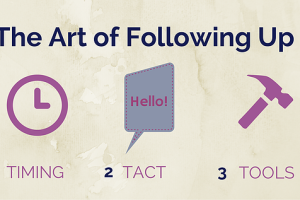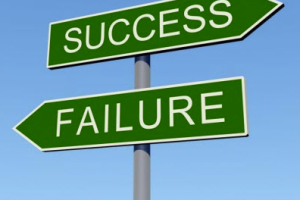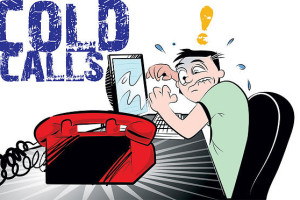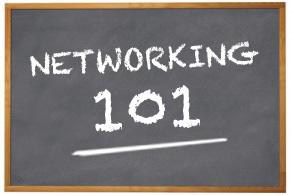There’s something uniquely challenging about following up with clients after a sales presentation. If we do it too soon, we risk coming across as overly eager to pocket a commission. On the other hand, if we wait too long, we risk being undermined by a competitor who happens to catch our customer at a better time to buy. And then there are the doubts: if they were really excited about our proposal, they’d be following up with us, right? Isn’t the very fact that we need to follow up evidence that we’re fishing in the wrong pond?
Not necessarily. Seasoned salespeople expect to make follow-up calls, often many calls, before netting a worthwhile sale. But they approach the task with a delicate balance of art and determination. They realize that, whether it comes by phone, email, or an in-person visit, each follow-up is a calculated effort to reengage a client—to kindle fresh interest in solving a pressing problem, to advance the case for why their solution makes the most sense right now.
But it’s not easy to do. Here are a few pieces of advice.
Don’t “touch base.” Add new value.
It’s so very tempting, when we make those follow-up phone calls or write those seemingly non-invasive emails, to resort to that comfortable mainstay of non-committal phrases: “just touching base.” We imagine that we’re communicating respect for our prospects’ time, but in fact we’re wasting their time unless we say or do something during the follow-up that offers new value. Our prospects know the truth: even though we may genuinely care about their needs, we’re still fishing for a sale. We’re not really “touching base” at all—not unless we’re calling to provide some kind of status update on work that the prospect has already requested from us. But that’s rarely the case.
The goal of follow-up communications is not merely to maintain contact, but to nurture prospects along the way. Nurturing is not the same as staying in touch. Nurturing means you add value. You try to help the email recipient move through the decision making process. Providing this kind of value requires some deliberation in advance of picking up the phone or hitting the “send” button. We have to spend some time reviewing what we know about our client’s needs—the things we’ve learned from pitching them in the first place—in order to determine how best to readdress those “pain points” in the follow-up. Your prospects want to work with someone who’s constantly thinking about how they can improve their business – we must strive to be that person!
Once we start thinking like our customers, we can communicate our availability to solve their problems without thereby moving in for an immediate, hard close. Forwarding a link to a relevant news feature, for instance, or sharing a story about how your company has recently addressed a similar problem on behalf of another client are infinitely better, more valuable additions to our prospects’ inboxes than a meaningless “just touching base” note. It won’t bother even the busiest executive if we spend a few lines describing (in hard-figure terms) how a particular product feature can improve his or her work-flow, but it has to connect with the reader’s immediate interests, not merely our own.
Yet we must be more that mere purveyors of boilerplate sales data. We don’t want prospects to feel as though they need to keep “holding out” for more information or a better deal, waiting for us to lay all our cards on the table before making a decision. We avoid this danger by approaching the task with the correct objective in mind. The salesperson often believes their objective is to present the solution – it’s not. Your real objective is to uncover and understand the prospect’s needs so that you can use what you have learned to obtain some commitment to advance the sale. We’re not calling or writing simply to present new information, in other words. We’re trying to match understood customer needs to specific product benefits. We’re extending the initial sales presentation, reengaging the prospect at those points that are most relevant and compelling for their immediate circumstances.
Vary the approach.
When we think of following up, we probably only consider the most obvious options: phone, email, text messages, and the like. But there are many other options available for communicating with prospective buyers in the 21st century, particularly in the blogosphere and on various social media platforms. These are the places, after all, where our customers are probably working out their most pressing problems, discussing the things that matter most to them. Salespeople must now think of themselves more like “mini-marketers” than “hard closing machines. We may not be the ones coming up with large-scope, strategic marketing plans for our products, but we still have to be “in the know” concerning our customers’ industries. If we hope to establish authority in those industries, we have to earn the right to be part of the conversations that our target customers are already having—even (if not especially) when those conversations don’t immediately concern what we have for sale. While it might sound counterintuitive, my goal is to help the customer before selling them. The selling will come, but by that point, I earned their trust by knowing what they cared about and actively contributing to the conversation.
That doesn’t mean that we should act like engineers when we’re not, nor does it mean that every salesperson needs to have his or her own blog or e-newsletter for customers to find. What it does mean is that our attempts to reach out to customers should reflect the variety of communication media that they are already using, and the content of our communications should leverage our knowledge of customer concerns to position us as thought-leaders in the market. A creative salesperson recognizes that following up with a client may take the form of something as implausible as commenting on an industry leader’s blog post about a completely unrelated matter, knowing that the target customer will probably be reading the same post at some point in time.
Meanwhile, because email is such a popular medium for following up, it deserves more consideration than many of us in the business world are accustomed to giving it. If we want to distinguish ourselves in our prospects’ minds, then we should make our emails stand out among the junk that clutters so many busy executives’ inboxes. Inc. If you want people to open your emails, consider this this advice for crafting your subject line: Subject lines should reflect topics clearly relevant to the prospect’s business, compelling them to open the emails rather than immediately scrap them. The sales message should get to the point quickly, stating very clearly “what’s in it for them,” and it should be told from the customer’s perspective. There’s a big difference between “Our product has this tremendous feature…” and “Our customers find that this feature helps them reduce their labor overhead by…” One sounds like a sales pitch. The other is a gentle call to action.
The most effective formula for eliciting a response from our customers is to use a strategic combination of phone, email, and social media follow-ups—all in the hopes of securing an in-person appointment for the “next step.” This gives us the chance to gently connect with clients and put a stalled deal back on the front burner for them. However, there are some ambivalent prospects who will respond only after a slightly more aggressive approach. Sometimes we have to demonstrate that we’re prepared to move on, with or without the prospect’s business, in order to shake them off the fence. Put a time limit on all your proposals is one I practice, which creates a sense of urgency, and it doesn’t lock you into a price for an extended period of time. Even if we desperately need the client’s sale, and even if we’ve already invested substantial resources in pursuing it, there are times when it just doesn’t make sense to let the customer leave the decision hanging indefinitely.
Be artfully persistent.
Still, it may surprise us how many follow-up attempts it takes before a client finally moves on a big purchasing decision. Not all sales will be equally complex, of course, and a lot will depend on where in their buying process a particular customer is when we first come in contact with them; but some of the most successful deals are netted after five or more calls. To put it another way: some of our biggest opportunities are still very much alive at the point when we’re conditioned to give up on them. That’s why, in sales as in life, persistence is a virtue.
But don’t foget – persistence requires craft, not stubbornness. There is a fine line between being a pest and being persistent. As we’ve already said before, unless we’re adding value to the customer’s experience, we’re wasting someone’s valuable time. Let’s think about the implications of that statement for a moment. If it’s true that our biggest deals may require five or more follow-ups before closing, then we’ll need to find five or more ways to creatively add genuine value at each point of contact. That’s a supremely daunting task—unless we’re skilled at framing the same potential customer benefits in multiple ways. We can do this by staying “in the know” about our prospects’ industries, becoming “conversation partners” and earning the privilege of discussing product benefits without thereby sounding like interactive sales brochures. This allows us to stay in front of our clients with a relevant, viable solution without becoming pests.
In closing, let’s not forget that, more often than not, a disengaged prospect simply hasn’t yet sensed a compelling call to action. We’re to blame for this as much as anyone, especially when our follow-up efforts are framed as mere “touching base” communications. Leaving the email open-ended with phrases like ‘let me know what you think’ or ‘keep in touch’ aren’t a strong enough incentive for your client to respond,” You’re more likely to get a response when you ask pointed questions like ‘What day and time works best for you next week to discuss this further?’ We have to remember that, by itself, even the best, most relevant information will not compel action in the absence of a clear “next step.” And that “next step” is easier to take when it requires only a modest investment from a newly engaged client.
Yes, following up is an art all its own. But it’s not one that only a few talented salespeople ever master, nor does it have to be a loathsome, dreadful task. On the contrary, for those who cultivate the ability to communicate value, following up is an exciting way to press pending deals toward a successful close.








